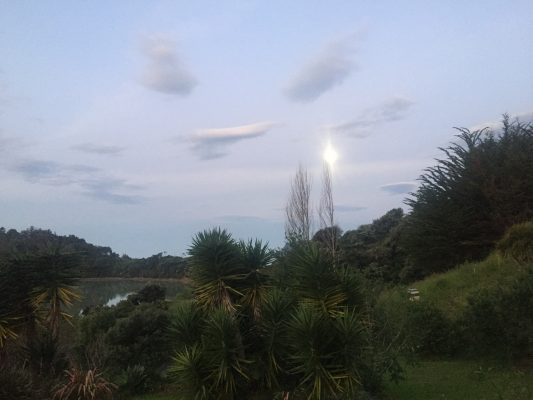Sa nou pa we: the ever-present unseen. This concept in Vodou speaks to the existence of everything we see, and all that we do not see. It speaks to the potent balance of light and dark, day and night, bright and shadow. Early in the initiation process, the initiate will spend time contemplating a candles light, in a completely dark environment. Next time you see a lit candle look at the flame for awhile. The flame has a dark outline encircling the candlelight. The depth and hue of the dark edge changes and transmutes as the light flickers and dances. It disappears if the light goes out. This dark edge is where light and dark meet. It always exists, somewhere in the world, whether seen or unseen.
This juxtaposition of dark and light is core to the Haitian tradition known as Vodou. Initiation is an acknowledgement that we, as temporary incarnation in a physical, human form, are essentially spirit, and light, in a material body. That we only see the external human form is part of daily spiritual practice. Our internal world is a dark space where we are always incubating and gestating the emergent and the new. We are literally birthing that which will meet the light, in the depths of the dark.
Vodou recognizes the potent and life serving connection between human life and the natural world, as well as the connection between the physical (human and natural) world and the spirit dimension. Simply put, humans mirror nature and nature is perhaps the most clarifying mirror to reveal who we are as humans, individually and collectively. Sacred movements in Vodou mirror the movements of nature, for example, the circling of the sun and the moon, the rise and fall of the day and night is the same as the opening and closing of our eyes. In the words of anthropologist Maya Deren (1953), the first westerner to document Vodou ceremony:
If the earth is a sphere, then the abyss below the earth is also its heavens; and the difference between them is no more than time, the time of the earth’s turning. If the earth is a vast horizontal surface reflecting, invisibly, even for each man his own proper soul, then again, the abyss below the earth is also its heavens, and the difference between them is time, the time of an eye lifting and dropping. The sun-door and the tree-root are the same thing in the same place, seen now from below and now from above and named, by the seer, for the moment of seeing (1953).
Each breath represents our ongoing exchange, inner and outer, with the universe. Nature mirrors us as a meeting place of light and dark. Our own bodies, existing in the physical plane, and because of our ability to stand and move in the upright dimension, becomes the vertical axis, the Poto Mitan, or axis mundi, between heaven and earth. The Poto Mitan is the center-space that is always present in ceremony. The circular Peristyle is the ceremonial place, and the Poto Mitan penetrates its circle at the deep center. The Poto Mitan is not, however, limited to ceremony; it is ever present. Its center point, the intersection of the world of Spirit (vertical) and the world of humans (horizontal) is the crossroads (Kayfou in Kreyol), “the metaphor for the mirrors depths….” (Deren, M.,p. 35). We can actually encounter the crossroads at any moment; and it is through our ongoing and daily communication with our own Universal Soul (in Vodou tradition, our connection to the Spirit world) that we both as individuals and as a collective body are in dialogue with the world of “L’Invisib” (the invisibles, unseen, or Spirit).
Both the winter and summer solstice are an opportunity to reflect on these Vodou teachings. In these days of longer dark, the natural world and spiritual realms are gestating the light. The spirits will often show up in the movements of nature, and so our own physical and global movements reflect and mirror Spirit. This is how our Universal Soul expresses itself, through us. This is how we mirror Spirit, the unseen, and therefore—anything and everything that exists in darkness, even if only for a moment. Honoring the winter solstice through recognition of, and willing connection to, our own inner darkness, shadow self, propensity for dark (and even dark acts that may be perceived as wrong-doing), we honor our own capacity for growth and life through hibernation and gestation. Many people resist or resent the darkness; in Vodou, our ability to be in and with the darkness is the most potent time for self-development and growth. We may not see the external, but we are still present in another form, just as daylight on one side of the earth marks night-time in another. To celebrate and be with darkness is to honor the most potent creative space for cultivation of self purpose and knowledge. This knowledge is not book knowing; its Konysans—the deep knowing of the body based on eons of ancestors, our literal bio-chemical composition as shared with the natural world, and the reality of the human body as a temporary (individual) and eternal (collective) axis mundi to divine, mirror, and reflect the sacred.


Full Moon Rising & Dusk at Delaware Bay, Nelson, NZ
References
Deren, M. (1953). The divine horsemen: the living gods of Haiti. Kingston, N.Y.: McPherson & Company
